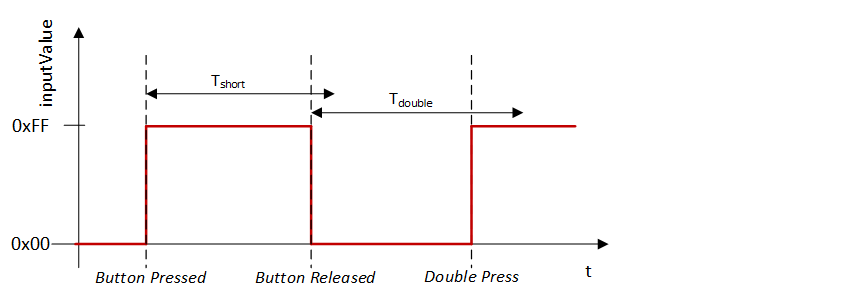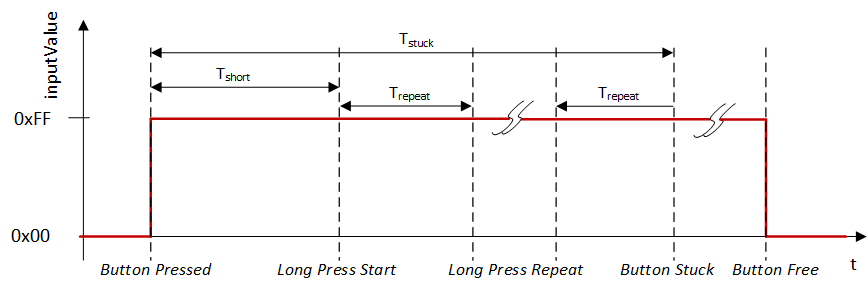Introduction
IEC 62386-301 describes DALI control devices that are defined as push buttons.
DALI control devices according to IEC 62386-301 correspond to instance type 1. The type of an instance can be queried with the function block FB_DALI103QueryInstanceType.
Input value
The current state (inputValue) of the push button can be queried via the function block FB_DALI103QueryInputValue. The value is 16#FF when the push button is actuated. The value is 16#00 when it is not actuated.
Timer
IEC 62386-301 defines specific timers with which the sending of the different events can be influenced.
The respective time is calculated from

Time | Multiplier | Preset value of the multiplier | Tincr incremental value | Tdefault default value | Tmin lowest possible set value | Tmax highest possible set value |
|---|---|---|---|---|---|---|
Tshort | tShort | Max (25, tShortMin) | 20 ms | Max (25, tShortMin) * 20 ms | tShortMin * 20 ms | 5100 ms |
Tdouble | tDouble | 0 | 20 ms | tDoubleMin * 20 ms | tDoubleMin * 20 ms | 2000 ms |
Trepeat | tRepeat | 8 | 20 ms | 160 ms | 100 ms | 2000 ms |
Tstuck | tStuck | 20 | 1 s | 20 s | 5 s | 255 s |
tShortMin: Vendor-specific (see tShortMin).
tDoubleMin: Vendor-specific (see tDoubleMin).
 | Set the times so that as few events as possible are sent. If too many events are sent, this can have a negative effect on the behavior of the application. |
Event filter
DALI control devices are capable of sending different events. The event filter consists of an 8-bit value, where each individual bit defines whether an event is disabled or enabled. The event is enabled if the corresponding bit is set, otherwise it is disabled.
The function block FB_DALI103QueryEventFilter can be used to read the value of the event filter; the function block FB_DALI103SetEventFilter can be used to write to it.
The event filter (see eventFilter) must be configured accordingly in order to trigger time-controlled events.
Bit | Event | Description |
|---|---|---|
0 | Button Released | The push button was released. |
1 | Button Pressed | The push button was pressed. |
2 | Short Press | The push button was pressed and quickly released again without being pressed again (short button press). |
3 | Double Press | The push button was pressed, released and quickly pressed again (double button press). |
4 | Long Press Start | The push button was pressed without being released in between times (long button press). |
5 | Long Press Repeat | If the push button was pressed for a long period (Long Press Start) without being released in between times, this event is sent at regular intervals. |
6 | Long Press Stop | This event is sent if the push button is released after a long button press. |
7 | Button Free / Button Stuck | If the push button is pressed for a very long time, it is assumed that it has stuck and the Button Stuck event is sent. Button Free is sent when the push button is detected as not pressed again. |
 | Release only those events that you need for the application. If too many events are sent, this can have a negative effect on the behavior of the application. |
Input Notification event
With instance type 1 it is possible to release different events with the help of the event filter. All events are sent from the DALI control device by a Input Notification and can be received with FB_DALIGetInputNotification.
The possible events (Event Name column) and their binary representation (Event Information column) are listed in the following table.
Event Name | Event Information | Description |
|---|---|---|
Button Released | 2#00_0000_0000 | The push button was released. |
Button Pressed | 2#00_0000_0001 | The push button was pressed. |
Short Press | 2#00_0000_0010 | The push button was pressed and quickly released again without being pressed again (short button press). |
Double Press | 2#00_0000_0101 | The push button was pressed, released and quickly pressed again (double button press). |
Long Press Start | 2#00_0000_1001 | The push button was pressed without being released in between times. |
Long Press Repeat | 2#00_0000_1011 | If the push button was pressed for a long period (Long Press Start) without being released in between times, this event is sent at regular intervals. |
Long Press Stop | 2#00_0000_1100 | This event is sent if the push button is released after a long button press. |
Button Free | 2#00_0000_1110 | Button Free is sent when the push button is detected as not pressed again following the Button Stuck event. |
Button Stuck | 2#00_0000_1111 | If the push button is pressed for a very long time, it is assumed that it has stuck and the Button Stuck event is sent. |
Short Press event

The Short Press event is triggered when the push button is released again within the time Tshort and not pressed again for at least the time Tdouble. If the push button is pressed again within the time Tdouble, a new Short Press event can be triggered.
Double Press event

The Double Press event is triggered when the push button is released within the time Tshort and pressed again before expiry of the time Tdouble.
Long Press Start, Long Press Repeat and Long Press Stop events

The Long Press event is triggered when the push button still remains pressed after expiry of the time Tshort. The time Trepeat subsequently starts. The Long Press Repeat event is triggered if this time has expired. If the push button remains pressed, the time Trepeat starts again and the Long Press Repeat event is triggered after each expiry.
The Long Press Stop event is triggered by releasing the push button.
Button Free and Button Stuck events

The Button Stuck event is triggered as soon as the push button was pressed for the time Tstuck without being released in between times. The Button Free event occurs immediately if the push button is released after the Button Stuck event.
The minimum set value for this time is 5 s; the default value is 20 s (see table above).
Note that the Long Press event does not temporally overlap the Button Stuck event, therefore the value should not be set too small.